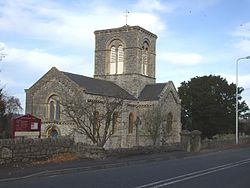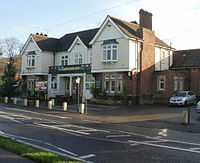Cleeve, Somerset
| Cleeve | |
| Somerset | |
|---|---|
 Church of the Holy Trinity, Cleeve | |
| Location | |
| Grid reference: | ST460660 |
| Location: | 51°23’28"N, 2°46’39"W |
| Data | |
| Population: | 902 (2011) |
| Post town: | Bristol |
| Postcode: | BS49 |
| Dialling code: | 01934 |
| Local Government | |
| Council: | North Somerset |
| Parliamentary constituency: |
North Somerset |
| Website: | http://www.cleevevillage.co.uk |
Cleeve is a village in Somerset, nine miles south-west of Bristol. It had a recorded population of 902 at the 2011 census.
Contents
History
Bronze or Iron age hill forts have been identified north of Goblin Combe close to the village at Cleeve Toot in Cleeve Wood.[1] It is a roughly oval settlement which is approximately 410 feet in length by 300 feet in breadth. Approximately 490 feet to the north is another, smaller settlement. They are thought to have been a satellite community of nearby Cadbury Hill[2] Pits have been found at the site indicating the presence of round houses.[3] There is a single stone rampart with a broad shallow outer ditch. There is also a prehistoric or Roman field system.[4]
Geography
Overlooking the village are several hills and valleys which support a rich diversity of wildlife.
Goblin Combe is a 128-acre biological Site of Special Scientific Interest.[5] of which 22 acres are managed as a nature reserve by the Avon Wildlife Trust.[6] A population of the nationally scarce plant stinking hellebore (Helleborus foetidus) grows on scree slopes in the combe, near Cleeve Toot; it is native at this site.[7] Limestone fern (Gymnocarpum robertianum), another nationally scarce plant, is also found here on limestone scree.[8] Other flowers include the autumn gentian, autumn ladies'-tresses and yellow-wort. The site also supports a varied collection of butterflies, with over 30 species recorded. These include grizzled and dingy skippers, brown argus and green hairstreak.
King's Wood and Urchin Wood are together another site of special scientific interest, overlooking the village, the designation covering 317 acres. The site has long been renowned for its botanical interest and records date back to the County Flora of 1893. The woodland supports a particularly high diversity of vascular plants, including populations of the nationally rare plant purple gromwell (Lithospermum purpurocaeruleum) and the scarce angular Solomon’s seal (Polygonatum odoratum).[9] Large areas of King’s Wood were replanted during the 1960s with beech (Fagus sylvatica) and a variety of conifer species including Douglas fir (Pseudotsuga menziesii), Lawson’s cypress (Chamaecyparis lawsoniana) and Norway spruce (Picea abies) . These crop trees have, however, largely been unsuccessful and the replanted areas are now being overtaken by hardwoods. King’s Wood supports nationally important populations of the rare and endangered greater horseshoe bat (Rhinolophus ferrumequinum) and dormice (Muscardinus avellanarius), and a nationally scarce chrysomelid beetle (Clytra quadripunctata).[9]
Cleeve Heronry is a heronry in a woodland near the village. 40 nests were counted in 1994. 47 nests in 2007. CCTV from one of the nests can be viewed at Cleeve Nursery in spring while the birds are raising chicks.[10]
About the village
Many of the residents of Cleeve commute to Bristol for work.[11]
The village has a number of businesses including, a beauty salon, plant nursery, boarding cattery, village shop, restaurant and two takeaways.
The three-storey Cleeve Court was built in a Gothic style for Rev. T.S. Biddulph in the early 19th century. It has been designated as a Grade II listed building.[12]
The Lord Nelson Inn, opened 1936, is the most striking and conspicuous landmark building in the centre of Cleeve and well-known to travellers on the A370. It was built between 1935-36 to directly replaced a public house by the same name, constructed circa 1799. The current building, designed by R. Edwards for Bristol George’s & Co. Brewery, is a rare local example of an interwar 'reformed' or 'improved' public house still retaining original facade and grounds, complete with function room, skittle alley and rear garden. Latterly owned by Greene King, the pub closed in late 2016.
Parish church
Cleeve, along with the village of Kenn, was previously part of the parish of Yatton. When the parish was divided public subscriptions were raised to build a separate church from local stone, with the Smyth Pigott family of Brockley Hall in nearby Brockley being the largest contributor. The foundation stone was laid in 1838 and the building consecrated in 1840. Cleeve became a separate parish of Cleeve with Clavenham, in 1843.[13]
The parish Church of Holy Trinity was built in a Neo-Norman style in 1840 by George Phillips Manners and is designated as a Grade II* listed building. Nave, north and south transepts, crossing tower and chancel. The nave has three bays with recessed bays to the north and south and a two-stage tower.[14] In 1888 the church was restored and renovated, and in 1898 stained glass was added to the west windows.[13]
Sport
At the heart of the village is the King George V Playing Field and Sinclair Pavilion which is home to Cleeve Cricket Club, Yatton & Cleeve United Football Club, and Cleeve Lawn Tennis Club[15] as well as many local skittles teams.
Outside links
| ("Wikimedia Commons" has material about Cleeve, Somerset) |
- Cleeve Village
- Cleeve Parish Council
- Yatton Moor Team Ministry
- Cleeve, Claverham and Yatton Scouting Group
References
- ↑ "Cleeve Wood, Somerset". English Heritage ALSF summaries. English Heritage. http://www.english-heritage.org.uk/server/show/ConWebDoc.5397. Retrieved 12 October 2008.
- ↑ Megalithic Portal: Cleeve Toot Settlement
- ↑ "Four enclosures on Broadfield Down, Somerset". North Somerset Historic Environment Record. Yatton, Congresbury, Claverham and Cleeve Archaeological Research Team (YCCCART). http://www.ycccart.co.uk/index_htm_files/Four%20enclosures%20full%20final.pdf. Retrieved 9 August 2017.
- ↑ National Monuments Record: No. 194816 – Cleeve Toot Camp
- ↑ SSSI listing and designation for Goblin Combe
- ↑ "Goblin Combe". Avon Wildlife Trust. http://www.avonwildlifetrust.org.uk/reserves/goblin_combe.htm. Retrieved 8 January 2011.
- ↑ Myles, Sarah. (2000). The Flora of the Bristol Region. p. 64. ISBN 1-874357-18-8.
- ↑ Myles, Sarah. (2000). The Flora of the Bristol Region, p. 59. ISBN 1-874357-18-8.
- ↑ 9.0 9.1 SSSI listing and designation for King's Woo and Urchin Wood
- ↑ "Heron Cam". Cleeve Nursery. http://www.cleevenursery.co.uk/index.php?option=com_content&task=view&id=21&Itemid=50. Retrieved 26 January 2008.
- ↑ "Council call for reduced speed limit". This is Bristol. http://www.thisisbristol.co.uk/news/Council-reduced-speed-limit/article-2608045-detail/article.html. Retrieved 10 January 2011.
- ↑ National Heritage List 1136522: Cleeve Court
- ↑ 13.0 13.1 "A short history of the Church at Cleeve". Yatton Moor Team Ministry. Archived from the original on 30 January 2010. https://web.archive.org/web/20100130084205/http://www.yattonchurches.org/Cleeve/cleeve_history.html. Retrieved 8 January 2011.
- ↑ National Heritage List 1129095: Church of Holy Trinity
- ↑ "Cleeve Tennis Club". Lawn Tennis Association. Archived from the original on 4 October 2011. https://web.archive.org/web/20111004103737/http://www2.lta.org.uk/Search/FindAClub/ViewDetails.htm?Id=1-60XGR&BSMGuid=a3592f35-a18a-4c4a-93b4-3b1ccda6a709. Retrieved 12 October 2008.


